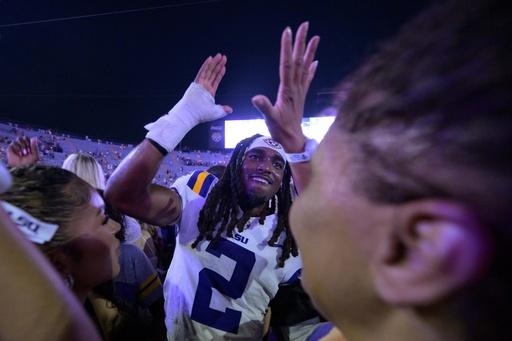
In Tennessee, a new fee tagged as a ‘talent fee’ will be introduced to sports ticket prices, while Arkansas plans a 3% increase in concession prices. Meanwhile, athletic directors from both Michigan and Michigan State have informed boosters that maintaining competitive winning teams will incur higher costs. Clemson also joins the trend by implementing an athletic surcharge to student tuition bills for the first time.
While college sports have always required funding, the landscape is shifting dramatically as players are granted opportunities to earn from their personal branding, making it apparent that fans are expected to shoulder a greater financial burden. “The professionalization of college athletics hasn’t reached its full potential,” stated Nels Popp, a sports business educator at the University of North Carolina. He believes institutions are still banking on the emotional connection fans have with their schools rather than adopting comprehensive marketing strategies, but changes are indeed prompting a transition toward more business-minded approaches.
Following the NCAA’s tentative approval of athletes receiving compensation for their names, images, and likenesses (NIL) in 2021, traditional booster contributions have shifted towards independent organizations, known as collectives, which are increasingly collaborating with universities to fund athlete compensation.
A significant change is forthcoming as a $2.8 billion lawsuit settlement is set to activate next year. Under this agreement, NIL arrangements will persist, while schools prepare for notable impacts on their finances, including the ability to distribute up to $22 million annually in revenue among athletes derived from various sources like ticket sales and broadcasting agreements. The NCAA’s annual payouts to Division I institutions will decrease to help cover damages totaling around $1.2 billion, transferring the burden to conferences that will experience reduced financial allocations, especially from the men’s basketball tournament.
Moreover, institutions will have the opportunity to provide additional scholarships across sports, translating to increased costs— for instance, the potential for colleges to award 20 extra scholarships in football could cost around $29 million in educational expenses, as estimated by Michigan’s athletic director Warde Manuel. In a recent communication to fans, he emphasized that sustaining quality across their extensive athletic programs would necessitate enhanced support from all stakeholders.
To address financial demands, Michigan may contemplate selling advertisement space at Michigan Stadium, a practice it has historically resisted. Additionally, a recent survey sought fans’ willingness to pay between $3,000 to $4,000 for premium chairback seats, which are limited in availability at The Big House.
Despite the growing financial obligations tied to supporting athletic programs, ‘donor fatigue’ is becoming apparent as some fans express reluctance to contribute further. The average cost for two spectators to attend a college football game in 2023 was about $180, in contrast to approximately $340 for an NFL game. Unlike professional sports, which are largely dominated by player salaries, college athletics had previously avoided such expenses. The emergence of NIL will further alter this balance. Michigan State’s athletic director Alan Haller shared that his upcoming budget would anticipate an additional $25 million to $30 million in costs.
Fans are undoubtedly faced with tough choices about continuing their financial commitments to assist players while hoping for better performance on the field. Yet, as witnessed at a recent Michigan-Michigan State game, opinions were mixed among fans about contributing further. One Michigan State supporter voiced frustration with rising educational costs, emphasizing that the substantial tuition fees were already overwhelming. Another fan from Ann Arbor expressed a firm disinterest in donating more, labeling the financial demands excessive.
Eastern Michigan’s faculty athletics representative, Rick Karcher, commented on the complexity of college athletics economics. Fans, alumni, and students still contribute financially, often overlooking the rising salaries of coaches and administrators because they perceive the athletics as an entity distinct from the university overall.
Several institutions, like Texas Tech, are grappling with increased financial requirements for athletic programs, budgeting approximately $14.7 million in support this fiscal year, a rise of nearly $9 million from the previous year. Texas Tech President Lawrence Schovanec noted that if any university department faced a similar revenue shortfall, adjustments would have to be made, which applies to athletics as well.
Florida operates its sports through the University Athletic Association, which not only facilitates sports funding but has also returned contributions back to the university. Recent reports indicated Florida’s sports revenue ranks eighth nationwide, fueled by substantial donations from key benefactors.
Institutions are clearly recognizing that sustaining college athletics requires more than just large donations. Tennessee previously ignited discussion during the football season with its announcement of introducing a 10% ‘talent fee’ on ticket renewals for the coming years, in addition to an existing 4.5% increase in ticket costs. “The link between available resources and competitiveness has never been more pronounced,” noted Tennessee’s Athletic Director, Danny White.
Arkansas’s athletic director, Hunter Yurachek, communicated that the 3% increase in concession prices was necessary to enhance revenue generation opportunities. Clemson’s new policy of adding a $150 “athletic fee” per semester to student tuition aims to raise between $7 million to $8 million, a strategic shift for a school known for offering affordable ticket prices to students. A student opinion reflected some skepticism regarding the new fee, balancing the merits of sporting success against rising educational expenses.
As collegiate sports increasingly demand substantial financial investments, the ongoing challenge lies in determining the sources of necessary funding. The question remains whether fans will accept new charges or changes, signaling a crucial point for athletic departments as they navigate this evolving financial landscape.
